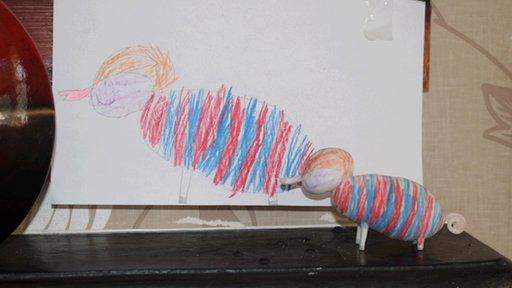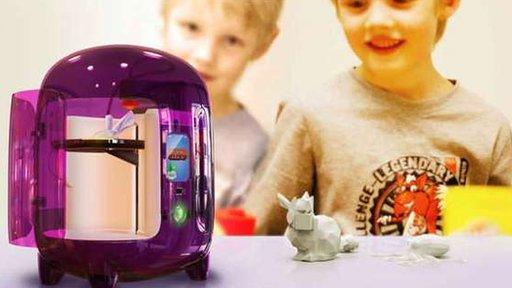Has 3D printing in the home been over-hyped?
- Published

Crayon Creatures turns children's drawings into solid objects
I have a stripy animal on my mantelpiece which is a 3D printed model of a drawing that my seven-year-old daughter made for me.
There is some dispute about what it is - the original artists claims it is an elephant while the firm that made it described it as a pig - but there is no dispute about how treasured it will be.
It was created by Crayon Creatures, a Barcelona-based firm which offers to turn children's pictures into solid objects. Customers need only send, scan or email their treasured scrawls.
It is a lovely example of the kind of thing that 3D printing can make a reality and something unimaginable just a few years ago.
Blank canvas
Since 3D printing hit the market and machines such as MakerBot made it affordable for ordinary people, there has been no end of hype about what is will achieve.
It will transform manufacturing as we all run off trainers, furniture, and objet d'art at home rather than go to the shops.
It will hail the next industrial revolution as the concept of mass-production is rendered obsolete.
But the reality is not quite the same, says 3D printing expert Joris Peels.
"The technology hasn't necessarily been overhyped but there is an element of 3D printer makers over-claiming in order to sell their devices," he said.
"The press has mixed up the capabilities of an industrial machine with what a desktop can do."
Lazy creatures
While industrialised 3D printing has been around for decades, printing in a variety of materials including ceramics, metal and rubber, the desktop versions are far more limited.
They have a long way to go before they can churn out consumer desirables in the same way and even when they are fit for purpose, people may not use them.
"Even if the perfect intuitive 3D modelling application were available for free then still most people would sit idle, staring at the ideal 3D printing app and the ideal 3D printer unable to come up with anything to make," said Mr Peels.
That is down to a basic lack of creativity, he thinks.
"Children make a lot of things but as we hit our teens we make less and we start to notice that consumer products are prettier. We become afraid of designing. We hit that blank canvas problem and think 'what am I going to make?' We are basically very lazy creatures."
Mr Peels was so convinced that the future of 3D printing lay with children that he designed a prototype child-friendly printer named Origo which he hoped to retail for around $800 (£524).
It was hailed by some headline writers as "the last toy your child will ever need".

The printer aimed to allow children to turn designs into toys
The project had investor cash but two years on the project has been abandoned.
"Basically I was unable to secure enough funding. It was heartbreaking to walk away from it," he said.
Child's work
Crayon Creatures has got around the blank canvas problem by letting the children do the designing while appealing to parents' innate fascination with their own children's drawings, however bad.
Founder Bernat Cunat admits that sometimes he has to check with the client what the drawing is actually of and which way up it goes.
He himself was inspired by his own five-year-old daughter, who noticed him playing around with designs on his own home 3D printer.
"She asked me if I could print one of her drawings and so I did. She was really happy with the design.
"I showed it to family and friends and started thinking that there was a chance that other people would like it too."
He got the website up and running within a matter of weeks and since going live in January, with no advertising or marketing, has shipped figurines to countries all around the world.
For him, 3D printing is incidental.
"Obviously it couldn't be done without 3D printing but the fact that it is 3D printed doesn't really matter.
"A lot of the stuff being made currently seems to be about justifying the technology but there are a lot of my clients who don't even know how their objects are made," he said.
Consumer goods growing

3D printed objects can be beautiful
Other firms are cottoning on to a market for 3D printed goods. Belgian giant Materialise previously specialised in industrial 3D printing but now also has an online store to showcase some of the possibilities for the home.
Autodesk also used to specialise in industrial-scale CAD (computer-aided design) software but now has a consumer division offering those with home printers a range of blueprints.
"It removes the complexity from design and means people don't have to start with a blank slate," said LeeAnn Manon, senior product marketing manager at Autodesk.
She envisages a future where shops as well as homes will increasingly offer 3D printing as an option, to allow consumers to help customise products
Among its community of users, Autodesk has found that a lot of home 3D printers are being used for DIY rather than product design.
"Lots of people are using their 3D printers for repairs. For example I have some drapes that rely on a plastic bracket that has broken, so I am going to print a replacement," said Ms Manon.
A 3D printer seems like something of an over-engineered solution to a broken piece of plastic so does she think that 3D printers will ever become as ubiquitous as other household essentials such as the microwave?
"I think it will... but what they will be used for is still undefined. Let's not forget that 30 years ago people asked why they would need a desktop computer in their homes," said Ms Manon.
Mr Peels, on the other hand, is convinced that home 3D printers will remain the preserve of a tiny minority of "passionate makers" for a while to come.
Either way, the possibilities are likely to surprise us. After all who would have predicted 10 years ago that we could unpin our children's drawings from our fridges and put them on our mantelpieces as ornaments?
- Published16 April 2013
- Published26 September 2012
- Published12 March 2013